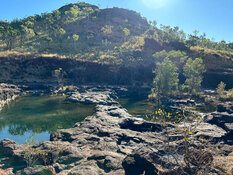Tom MacNeill: Actually I think the greatest challenge is behind us. The world capital markets are now less volatile.
It's true that Saskatchewan has everything that the developing world needs. We're geologically blessed. Half of Saskatchewan lies in the Western Canadian Sedimentary Basin, with all the hydrocarbons and sedimentary resources you could imagine, potash being our primary asset so far. The northern half of the province is underlain by the Precambrian Shield, so we also have just about every hard rock mineral asset known to man that can be exploited economically.
The only downside is that we never had a capital market that caused a great deal of development in those resources. As some people know, we are the birthplace of socialism in North America. In the 1940s we elected the first socialist government ever in any North American jurisdiction. We made some extraordinary choices—to some degree along the path that Barack Obama is taking the U.S. these days—in that we had tremendous government oversight of all facets of life, including resource exploration and development.
Government hooks in business spook away a regular capital market. Much like Hugo Chavez expropriating assets in Venezuela today, it tells the rest of the world "stay out" because there's too much sovereign risk. We did that to ourselves. We went through a whole period where we ruined our economic activity because we thought socialism was the neat thing. We came out of it, but we're still living the hangover.
That means that we have an opportunity suite unparalleled in the world because we simply didn't develop it even though we knew it was there. The inroads that 49 North has been making are to develop a capital market. Several hundred companies are exploring for various resources in Saskatchewan now, and while I'm developing local interest and awareness, there's a tremendous investment opportunity for people external to the province.
TER: Do you see the direction in which Obama is taking the U.S. as additional opportunity for capital markets in Saskatchewan? Or might Saskatchewan catch socialist fever again from the U.S.?
TM: No, we won't. Been there, done that. We know what happens when you have government oversight in resource development and the backbone of our economy is resource development. We're the largest exporters of uranium and potash. We have incredible undeveloped hydrocarbon resources in light oil and gas, heavy oil, bitumen in the oil sands that is equal to if not greater than Alberta's. Also, immense resources in coal.
We're not going to screw up a second time. We watched Alberta develop from a base of 800,000 people to a population of 3 million people while we stayed stagnant at one million people over the last 50 years. It's not going to happen again. Saskatchewan is immune now because of our previous experience, so to some degree that will make us very attractive to capital worldwide.
Canada has always been mining- and resource-friendly. The U.S. is becoming more and more restrictive. Put a green stamp on something and everybody loves it; put a mining stamp on it and everybody hates it. That's becoming a very challenging environment, so we see a tidal wave of money flowing into Saskatchewan to take advantage of opportunities we have kept in the ground.
TER: You're in the catbird seat of having all these untapped resources.
TM: And we couldn't be happier about that. We are in the best place of any jurisdiction in the world. We have virtually zero sovereign risk because of our previous experience, tremendous undeveloped resources, more roads per capita than anywhere because we have all the infrastructure that socialists like to build. Power lines and gas lines run everywhere. Even our left-wing friends in previous administrations started developing good policy and resource royalties. We've set the playing field such that we'll be the belle of the ball for the next 100 years.
We've got it all and we're happy to be a part of early-stage development. That's what 49 North is about, pointing fingers at good projects. We invest in third-party projects through equities or other instruments, and we also develop our own. We're absolutely tickled about the opportunities ahead.
TER: You develop your own projects?
TM: Yes. Because we have a corporate structure, we can actually develop our own projects, which we do. We go out and stake ground, we tender for oil and gas leases, and all of that. We don't just develop things in Saskatchewan, either. We have a strong focus on Saskatchewan, but we look anywhere in the world.
TER: Your site talks about ensuring that all stakeholder interests are well managed, including local stakeholders. Can you elaborate on that?
TM: Typically a mantra with local stakeholders is that if external capital comes in and develops a resource, it's "exploitation"—with the negative connotation. I think of exploitation as making the highest, best use of a resource, but oftentimes the word conveys abuse instead. If you're going to mine large tracts of land with an open pit or go underground, you have to make sure that all stakeholders are well-served. How do the locals feel about it? What does it mean with regard to job creation? Will there be drags on infrastructure? We have to make sure it's done right. Cameco Corp. (TSX:CCO) has proven in spades that it can be done right.
TER: And how do you ensure that the interests of financial stakeholders are well managed?
TM: With regard to those who put up the capital, government policy fixed a lot of that internally already. Most people aren't aware of it, but PotashCorp (NYSE/TSX:POT)—one of the most successful companies in the world and certainly the most successful potash mining company in the world—was created through legislation that virtually expropriated half the industry. That was unwound when Potash was taken public again in the 1980s, but it's probably the best example of how badly Saskatchewan ever treated any financial stakeholder. We're not going back there.
The best way to treat financial stakeholders is to have their dollars well-spent on a project and make sure the project attracts further capital. It's a kiss of death when a good project cannot raise money, so 49 North's sponsorship and capital resources can get projects from very early-stage exploration into the development phase, where larger sums can be raised by others without it being hyper-diluted.
TER: Given such abundant natural resources, how does 49 North prioritize which resources?
TM: Everything tends to move in tandem. But we do get specific. A couple of years back we kicked out most of the uranium exposure in our portfolio and haven't really gone back into it heavily because I don't think it's quite time. Probably late 2010 or early 2011 will be time to do that. I guess what I'm saying is that we look at the commodity, where it is in the cycle, the macroeconomics around it and what the projects are.
After we figure out the macroeconomics, we answer other important questions. What do we think about the short term and short-term pricing? What will the capital market say about this? Can we finance the project moving forward? Is it the right time in the cycle? Just about everything I can imagine has seen what I'd consider the short-term bottom in its commodity price, so now is a good time to be putting things back on the books.
Potash has run its cycle in that it's gone up and down in value. We've seen a floor in that price and now it's time to start moving on to other things. The potential potash producers are very long-term stories; oil and gas aren't. The physical in uranium has been trying to make a bottom. It hasn't done that yet. Probably we're going to see the entire energy complex come off quite a bit in the first half of this year and that will likely be the final medium-term bottom in the price of physical uranium. We're usually making our investments at the bottom of the price cycle, when that commodity's out of favor. Right now we're focusing on light oil in Saskatchewan—we've been doing that for the last six months—and base metals. It's time for that.
TER: We're at the bottom of their cycles so you're starting to invest in them?
TM: I think we're near the bottom. We saw probably the absolute bottom in oil, but I think it's going to roll over significantly in the first quarter or at least in the first half of this year, for a variety of reasons based on the global macroeconomics and the perception of a lack of demand and worldwide consumption. But having said that, I don't try to pick a perfect bottom. Any time from a year ago to two years from now is a good time to put together a project for most commodities.
TER: Do you expect production from your oil investments to go to markets outside of North America?
TM: No. Saskatchewan is Canada's second-largest producer of oil and gas, and we typically ship most of our oil to the U.S. We're actually a larger exporter to the U.S. than Kuwait. Our political and economic past puts us way behind the curve, so peak oil is a generation ahead of us. Alberta's oil production has been climbing again on the back of the oil sands, but it hit peak oil on the conventional side in 1983. In 2010, we're essentially where Alberta was in the 1950s. We're far away from seeing maximum production. We produce about a half million barrels of oil a day now, and probably can get up to 3 to 5 million barrels 20 to 30 years from now.
And Saskatchewan probably has just as much bitumen as Alberta, but just started to develop it as of 2004 because we never had a policy that allowed development. We used to also have SaskOil, a crown corporation that had a prohibitive royalty structure for non-crown entities, which essentially scared away all other production.
TER: Will peak oil in Alberta (or anywhere else) help drive oil prices up to Saskatchewan's benefit?
TM: Ultimately, yes. Near term, I expect oil to go down sub $50 or so, but over the next five years, I believe we'll see $200 oil because it's easy and people consume what's easy.
The entire energy complex will pull hydrocarbon prices up. India has two days' coal supply and they're cutting back and rationing power in China. That puts tremendous pull on energy prices in the entire complex. The Dow Jones Basic Materials/Coal Index has gone from about $140 to $540 over the past year, almost a 45º climb on a chart. Any way you cut it, the rising value of one energy source puts upward pressure on the rest. Down the road, that will include uranium because nuclear generation will be the only substitute for thermal coal in countries with tremendous power needs. All of that will drive prices across the energy complex higher.
TER: How should investors play this momentum?
TM: It's hard for me to say because I'm a junior resource guy and I'm there at the very early stages. The place I live in is the 10-cent equity that we take to $3 to $5; not the $15 stock that goes to $50 because all of a sudden there are 100 years of production ahead. As an early-stage guy, I'm usually spending money when everybody else is shunning a particular commodity or project or area. In some ways what we do at 49 North is either countercyclical or ahead of the cycle.
TER: In terms of being countercyclical and focused on junior resources, what are some interesting junior resources plays that investors should look at?
TM: Definitely pay attention to potash. It's absolutely a necessary nutrient for growing crops. You can't do without it. The salt beds in Saskatchewan contain 50% of the world's mineable supply, so Canpotex (Canadian Potash Exporters) has become the world's largest supplier, with a bit of a monopoly or oligopoly on potash. Right now Canpotex is scuffling with China over pricing. Russian potash producers have settled a contract for $350 a ton with the Chinese and Canpotex seems in no mood to take that little. This gives juniors a tremendous opportunity to step in.
TER: Juniors such as?
TM: My two favorites are Athabasca Potash (TSX-V:API)—my number one holding—and Potash One (TSX-V:KCL). Both are world class. API trades at about $6.50 per share. It's a very light market cap with 39 million shares outstanding in the context of a conventional project that's billions of dollars in scope and can have mine life between 50 and 100 years. BHP Billiton Ltd. (NYSE:BHP) plans to build one of the world's largest potash mines right next door to Athabasca Potash's project. Likewise, Potash One has an excellent, scalable solution mining project in southern Saskatchewan that is equal in merit by my estimation.
TER: Didn't you indicate that the potash cycle is done?
TM: I meant that potash pricing has gone full cycle—from $70 a ton five years ago to a peak of $1,000 or so in 2008 to recent contracts signed at $350. Having seen the floor, for the time being 49 North doesn't need to think about the projects we hold. We can look at other things.
Even if you know the resource is there, it takes five to eight years to bring a potash mine on stream. This stuff is buried a kilometer deep. It's technically challenging and takes a great deal of time from early investigation to permitting to sinking the shafts to building the facility and extracting the potash. So I would be paying attention to junior potash explorers now because these are long-term projects and the price won't stay at $350. You can buy and hold those projects and wait and see what happens. The comment I made earlier was based on what 49 North plans to do. We're comfortable to let our potash holdings be and watch how it plays out.
TER: Is Saskatchewan's potash dominance threatened by Amazon Mining (TSX-V:AMZ), which is drilling on a big potash play at their Cerrado Verde project in Brazil?
TM: Not at all. More power to them. In my lifetime the population of this planet has doubled, growing from 3 billion to more than 6 billion. Demand growth for potash will continue. We're just realizing the shortages in the market now, and because it takes a long time to bring these things to production we'll see supplies tighten up even further.
The Brazilian agriculture industry, if it isn't already the world's largest consumers of potash, is on the verge. Good on them. Amazon is doing very well and has a very large resource. I hope it will be easy for them to mine. The local supply will take out all of the transportation costs. The potash content is lower (11%) than what we mine in Saskatchewan. Typically, ours runs from 20% to 25%. Theirs uses different processing mechanisms and has a different chemical structure. But it's all potash and more potash production is a good thing.
You get much better crop yields if you apply the recommended amount of potash to the soil. The more that is mined, the more that is put on fields, the better the harvests are, and the better we can feed the growing population. That is good for the potash industry, so I have very little fear that we're going to see potash prices turn down below $350. In fact, I think that we've seen the bottom and they're going to go up indefinitely from here.
TER: Will population growth be enough to absorb the additional production, though?
TM: It takes a certain amount of potash to produce what a cow eats and seven times more if you're going to eat that animal's meat. It takes a great deal of potash to make all that feed. That's an undeniable fact of life. India has 1.2 billion people and China has 1.1 billion or more. A lot of Asians are moving up the economic ladder, which is creating tremendous demand for potash. As people by the hundreds of millions move up the food chain, it creates an exponential demand for potash. About 400 million people in China are moving into the middle class, and an extraordinary thing that happens when your standard of living improves is switching from starches in your diet to proteins—meat, for example.
TGR: What other opportunities do you see for investors in those masses of Asians moving into the middle class?
TM: Any advancement in civilization is great for commodities. China overtook the U.S. as the world's largest consumer of automobiles in 2009. They are building more cars for all these people. To build cars, you need everything from rubber, lead, zinc and tin to hydrocarbons for the plastics. You need base metals. Hybrids or electric cars need rare earth elements—lithium, neodymium, all of those hard-to-pronounce elements in the lanthanide and actinide series. Cars need roads, so they need asphalt. Roads need bridges when they come to a river, so they need concrete. That means limestone and kaolin and iron and thermal coal. And coking coal to make the steel to build the bridge.
So infrastructure development will drive the commodity cycle going forward. That's an unstoppable force. We saw that in North America in the 1800s and 1900s and we're seeing it elsewhere now. That is tremendous for virtually all commodities. It's even better for Canada because we're a commodities country and it's the best for Saskatchewan because we've got just about everything and we're ready to supply it to the world.
TER: One of your top 10 holdings, Pinetree Capital Ltd. (PNPFF.PK), is interesting in that it's almost like 49 North.
TM: The work that Sheldon Inwentash (Chairman and CEO) and his crew do is similar in a lot of ways. We did a stock swap with Pinetree, so they hold 49 North paper as well. That promotes deal flow through the two enterprises. We offer early-stage opportunities for Pinetree in western Canada and especially Saskatchewan, and part of what we gain from holding Pinetree is tremendous exposure to a bunch of junior and intermediate uranium explorers.
I've often said that if I wanted exposure to uranium, I would simply buy Pinetree because if uranium hits bottom this year and starts moving up to $50, $60, $70 per pound, Pinetree is probably the best place in the world to get exposure to that. We're happy to hold Pinetree shares for that reason, not to mention the many other great investments in their portfolio.
TER: But you also have uranium in Saskatchewan.
TM: A lot of Pinetree's holdings are companies exploring in Saskatchewan, which holds the largest uranium resource in the world. In fact, we supply 20% of the world's reactor-grade uranium. The Athabasca sandstone basin has the highest-grade uranium in the world. A couple of the mines regularly bring out ore that is 25% uranium. Hathor Exploration Limited (TSX-V:HAT)—which in my estimation has one of the best near-term potential productive resources in the world—has had intersections as high as 80% uranium over multiple feet.
That's incredibly hot rock and a tremendous resource. Hathor stepped out a couple hundred meters and found what looks to be an analog to the resource they have already and that's one of the things they will be focusing on with the four rigs they have drilling during their winter program. I would encourage people to pay attention to Hathor. They've found a tremendous, world-class resource that is probably eminently mineable, and they know what they're doing.
TER: You're enthusiastic about what you do.
TM: Hey, I've been in this business my entire life and I've stuck to the junior resource end. It's fun. It's populated with very interesting characters. It's also very lucrative. I like riding a story from initiation, whether from a nickel or a dime to a few dollars or even $10. Occasionally you'll catch a ride that takes 10 cents to $20. That's a thrilling world to be in, but you have to be a lifer. You have to know what you're doing. It's management first, resource second. Unfortunately, people usually bet on the commodity without realizing that management may not know anything about it.
TER: Is your next challenge finding the time and the people to get all these projects done?
TM: It's the people. Here's an example to help me illustrate that point. Rallyemont Energy, a potential heavy oil producer, formed last year and soon to be publicly traded. They've garnered a tremendous land position. From historical drilling, they know the oil—from 10 API to 15 API (API=American Petroleum Institute)—is there. The project probably needs about $20 million. Once that is raised, they'll need $200 million to develop it. We can't raise that kind of capital locally, so we have to raise it externally.
In Rallyemont's case, they have a tremendous management team, so we can do that, but with other companies, this is where we run into problems. The local company needs local expertise. We've been shipping people out of Saskatchewan. We educate them here and they move away, so it's hard to find good management. We need to bring some people back and that's beginning to happen already.
Even so, finding five Rallyemont-caliber management teams here would be a stretch, so one of the biggest challenges is populating the companies to develop these resources with capable people. With 49 North acting as a sponsor, we have the capital market and there's no shortage of good projects. Now we need the people to go with them.
TER: Any other projects you'd like to tell us about?
TM: One of the exciting development stories on our plate is NuCoal Energy Corporation, a private company. They have a tremendous project—billions of tons of proven lignite coal in southern Saskatchewan. They're going to build a coal-to-liquids (CTL) processing plant that probably will cost about $6.5 billion. NuCoal has a memorandum of understanding with Sinopec, China's second-largest energy company, to provide contracted services to move that project forward, with the final design, construction and commissioning of its first CTL operation in Saskatchewan.
A high-level advisor to the Chinese Sovereign Wealth Fund and I had a discussion not long ago, and my observation to her was that we have incredible projects, but they need billions of dollars in financing to move forward and we don't have that kind of money. Her response was that China's problem is the exact opposite—trillions of dollars and not enough projects to supply the country's demand for resources.
To make a long story short, the developing world, especially China, knows what Saskatchewan has to offer. Over the next 25 years—or any other time period going forward—we will see our resources developed. One reason I'm so excited about the opportunities here is that we have first-mover status. We get to be in the very early-stage seed capital that can be so lucrative.
TER: You have a wonderful story and we appreciate you taking the time to share it with us.
Like many others in commodity country, Tom MacNeill of Saskatoon is a resources guy. Four years ago, based on a sentiment shift suggesting that Saskatchewan was open for business, he established 49 North Resources Inc. basically an incubator fund to raise capital for early-stage projects to develop resources throughout the province. Officially, he serves as President, CEO and Director of 49 North; unofficially he also can arguably lay claim to the Saskatchewan Head Cheerleader title too. A graduate of the University of Saskatchewan (economics with a geology minor) and a Certified General Accountant (CGA), Tom also completed the Canadian Securities Course (with honors) in 1987 and is a Chartered Financial Analyst (CFA). With 25-plus years of experience in resource investment and corporate finance, his work history includes positions as an investment advisor with a major Canadian brokerage firm, management accountant within the mining industry, Chief Financial Officer of a Canadian trust corporation, and extensive resource portfolio management. Since the early 1990s, his focus has been exclusively toward Canadian junior exploration, development and mining opportunities with particular emphasis on Saskatchewan's increasingly important resource sector.
Want to read more exclusive Energy Report interviews like this? Sign up for our free e-newsletter, and you'll learn when new articles have been published. To see a list of recent interviews with industry analysts and commentators, visit our Expert Insights page.
DISCLOSURE:
1) Karen Roche of The Energy Report conducted this interview. She personally and/or her family own none of the companies mentioned in this interview.
2) The following companies mentioned in the interview are sponsors of The Gold Report or The Energy Report: Amazon Mining
3) Tom MacNeill—I personally and/or my family own shares of the following companies mentioned in this interview: Athabasca, Hathor, 49 North. I personally and/or my family am paid by the following companies mentioned in this interview: None













































